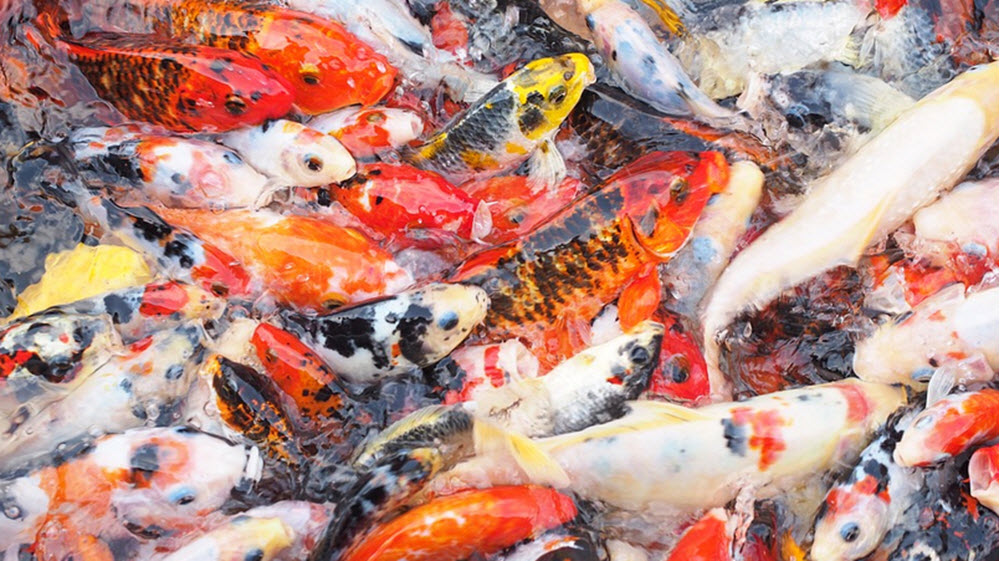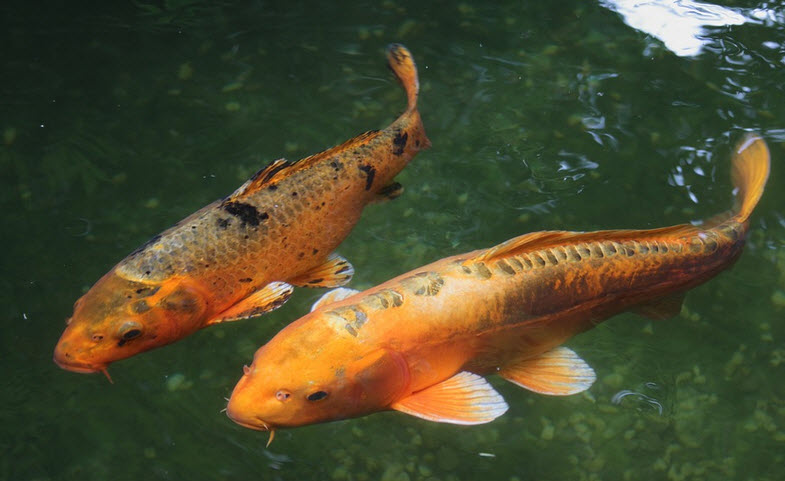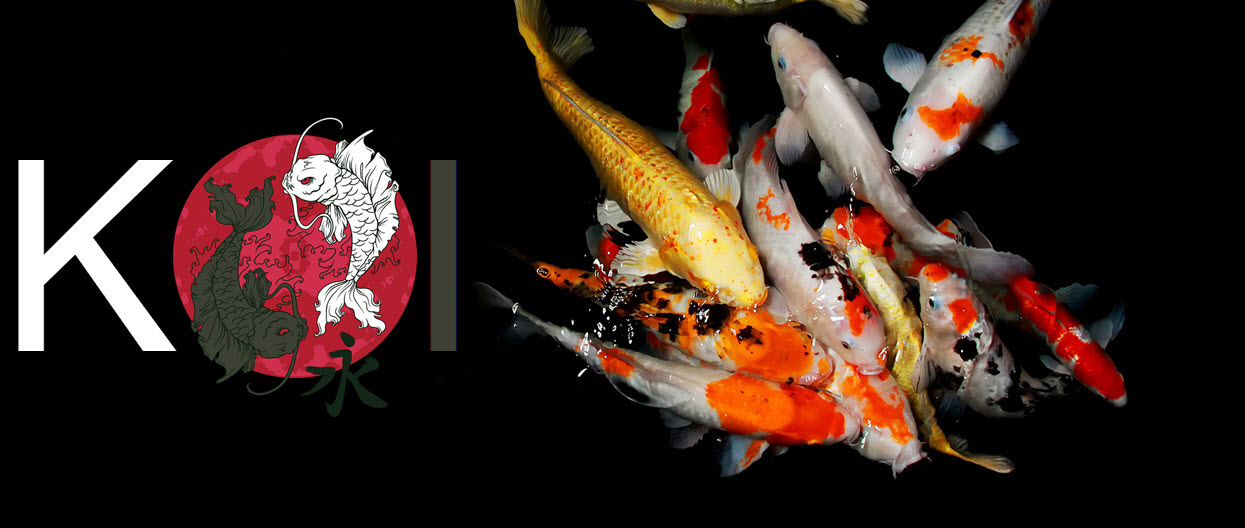Koi breeders have developed a wide range of koi varieties that differ from each other when it comes to aspects such as coloration, patterns, shine, and scalation. Over a hundred different varieties of koi have been named, and the field is growing continuously.
One of the main organisations keeping track of the different koi is Zen Nippon Airinkai, which has placed the known varieties in 16 different groups.
Example: The well-known Kōhaku, Taishō Sanshoku, and Shōwa Sanshoku varieties all belong to the category Gosanke (御三家).
Below, we will take a look at some of the named varieties of koi.

Kōhaku (紅白)
In Japanese, the name of this variety means “red and white”. The kohaku koi is white-skinned, with large red markings on the top. It was one of the first ornamental varieties of koi, and it has been kept and bred in Japan since the late 1800s.
Utsurimono (写り物)
The base colour of this koi is black, with markings in another colour forming a sort of zebra pattern. The markings can be yellow, red or white.
The oldest attested version of this variety is the one with yellow markings. When it first appeared in public in the 1800s it was called Kuro ki madara (黒黄斑), which is Japanese for “black and yellow markings”. In the early 1900s, this version was renamed Ki Utsuri (黄写り) by renowned koi breeder Elizaburo Hoshino.
The version with red markings is called Hi Utsuri (緋写り).
The version with white markings is called Shiro Utsuri (白写り).
The Japanese word “utsuri” means “to print” and is a referrence to how the black areas of the fish
can look like ink stains against the contrasting white.
Shūsui (秋翠)
This koi variety was created by the breeder Yoshigoro Akiyama in 1910 and is notable for not having any scales except for a single line of big mirror scales that run dorsally from the dead to the tail. The most common version of Shusui sports a pale blue or greyish colour above the lateral line, and is red or orange below the line and on the cheeks. The name Shusui means autumn green.
Allegedly, Yoshigoro Akiyama created the Shusui by crossing Asagi koi with German mirror carp, but this has not been proven. The wild ancestor of koi is Amur carp (Cyprinus rubrofuscus), while German mirror carp (Cyprinus carpio carpio) is a subspecies of the European carp. Although no longer recognized as the same species, they are closely related and the Amur carp was earlier considered a subspecies of the European carp and had the scientific name Cyprinus carpio haematopterus.
Taishō Sanshoku (大正三色)
This variety is also known as Taishō Sanke. It was introduced to the public by the koi breeder Gonzo Hiroi in 1914. It looks very similar to the white-and-red kohaku, but features small black markings known as sumi (墨).
Shōwa Sanshoku (昭和三色)
This variety is also known as Shōwa Sanke. It is a black-skinned koi adorned with both red markings (hi 緋) and white markings (shiroji 白地). It was first introduced to the public at an exhibition in 1927. Since then, breeders have increased the white markings in showa sanshoku koi, and some specimens are even difficult to distinguish from taisho sanshoku koi.
Bekko (鼈甲、べっ甲)
The Bekko can be white, red or yellow, but always have distinctive black markings. In Japanese, the name means tortoise shell. The white variety is called Shiro Bekko (白), the red variety is Aka Bekko (赤) and the yellow one is Ki Bekko (黄).
Asagi (浅黄)
This koi is light blue above. Below, most specimens are red, but some individuals are pale yellow or cream instead. Sometimes the cheeks also display this colour.

Koromo (衣)
The koromo koi was developed in the 1950s, probably through crossing kohaku koi with asagi koi. The koromo koi is white with a kohaku-style pattern, and sports certain other distinguishing features which vary depending on koromo version. The koromo koi exists in several different versions, of which one of the most common is Ai Goromo (藍衣), which looks like a kohaku but with blue-edged or black-edged scales over the red markings (hi 緋). Another example of a koromo version is Budō-Goromo (葡萄衣), which has a dark burgundy hi (緋) overlay. Sumi-Goromo (墨衣) is similar to Budo-Goromo, but the hi (緋) pattern is of an even darker shade of burgundy. In some lights, this shade will look black rather than burgundy.
Goshiki (五色)
This is a koi where the base colour can range from almost black to pale sky blue. Most individuals have a dark base colour. Goshiki kois sports a red Kohaku-style hi pattern over reticulated scales (a so-called fishnet pattern), and there are litte or no hi markings below the lateral line.
In Japanese, the name Goshiki means “five colours”.
Hikari-mujiimono (光無地もの)
In Japanese, the term hikari means light / shine / gleam. When you see the term Hikari in the name of a koi, you can therefore assume that the fish will be shiny.
One example is the Hikari-mujiimono (光無地もの), which sports coloured markings over a shiny metallic-looking base. (Some individuals display two metallic colours).
Hikari-utsurimono (光写りもの)
The Hikari-utsurimono (光写りもの) was developed by crossing Utsurimono koi with Ogon koi.
Ōgon (黄金)
An Ogon koi has a metallic sheen and only one colour (hikarimono 光者). Most individuals in this category are solid gold, solid orange or solid platinum.
An important breeder in the history of Ogon koi is Sawata Aoki, who developed a famous Ogon koi in 1946 using a wild carp he had caught back in 1921.
Chagoi (茶鯉)
Chagoi koi can be anything from brown or pale olive-drab green to copper, bronze or darkish orange. The name means tea-coloured. Chagoi koi usually grow big.
Ochiba (落葉)
The base colour of this koi is light blue or grey, while the Khaku-style pattern can be anything from yellow to copper and bronze. In essence, the pattern is coloured like leaves in fall, and Ochiba aptly means “fallen leaves” in Japanese.
Doitsu-goi (ドイツ鯉) ( 独逸鯉)
Doitsu-goi koi was developed by cross-breeding established koi varieties with selected European carps (Cyprinus carpio) that only had a single line of scales along each side of the dorsal fin.
There are four main Doitsu patterns:
- A row of scales running from the front of the dorsal fin to the end of the dorsal fin (along both sides of the fin).
- A row of scales runs from where the head meets the shoulder to the end of the fish (along both sides).
- A row of scales runs from where the head meets the shoulder to the end of the fish (along both sides), but there is also a line of scales visible along the lateral line along the side of the fish. This second line of scale tend to consists of especially large scales.
- The fish is completely or almost completely covered in big scales. Since they resemble plates of armer, this koi is nicknamed armor koi. In Japanese, it is also known as Kagami-goi. (Kagami means mirror.)
What´s a Kumonryū (九紋竜)?
It is a black doitsu-scaled koi adorned with curling white markings. The name means “nine tattooed dragons”, since the pattern is similar to Japanese ink paintings of dragons.
A metallic-skinned version of the Kumonryu has been developed; it is named Kikokuryū (輝黒竜). If a Kikokuryu has a Kohaku-style pattern, the fish is called Kin-Kikokuryū (金輝黒竜) which roughly translates into “gold glitter black dragon”.
What is Kinginrin (金銀鱗)?
Kinginrin versions have been developed for almost all the koi varieties. The scales of a kinginrin koi has a metallic sheen to them and glitters a lot in the right light. The name Kinginrin means “gold and silver scales”. In the trade, you may encounter the abbreviation Ginrin.
What´s a Tanchō (丹頂)?
A Tanchō (丹頂) is any koi that sports a red solitary patch on its head. It can for instance be a Tanchō Shōwa or Tanchō Sanke.
The name alludes to the red-crowned crane (Grus japonensis) which is called tanchō in Japanese.
What is Kawarimono (変わり物)?
Kawarimono (変わり物) is a “catch-all” term used for koi that doesn´t qualify for any of the official categories. In competitions, new variants of koi that haven´t been officially named yet can register in the Kawarimono category. Therefore, you may see very different koi variants compete against each other in this heterogeneous category at large koi exhibitions.
Are Ghost koi real koi?
This subject is up for debate. Ghost koi was developed in the 1980s by crossing Ogon koi with wild carps. The result was a fish with very eye-catching metallic scales. Some koi keepers do not recognize them as true nishikigoi, while others point out that there are other koi varieties that we know (or suspect) contain genetic material from non-koi fish.
